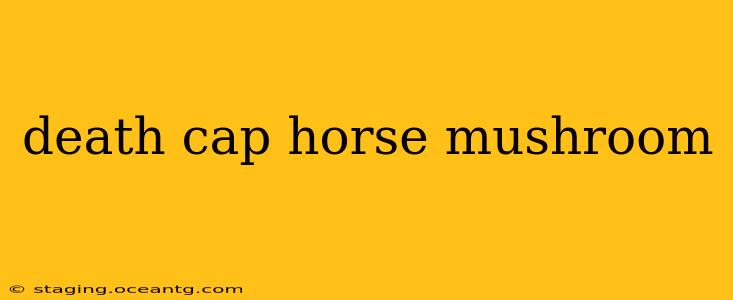The death cap mushroom (Amanita phalloides) and the horse mushroom (Agaricus arvensis) are frequently confused, leading to potentially fatal consequences. While both are large, white-gilled mushrooms, their differences are crucial to understand. Mistaking a death cap for a horse mushroom can be lethal, as the death cap is one of the deadliest mushrooms in the world. This guide will highlight the key distinguishing features to help you confidently identify these two species and avoid a tragic mistake.
What are the key differences between Death Cap and Horse Mushroom?
The most important distinction lies in several key characteristics, which, when examined carefully, will reveal the crucial differences. Relying on a single feature is dangerous; always consider the whole picture.
1. Cap Color and Texture:
-
Death Cap: Typically olive green to yellowish-green, sometimes appearing almost white, but often with a noticeable greenish tinge. The cap is smooth and slightly sticky when moist.
-
Horse Mushroom: Generally white to creamy white, sometimes with a slight tan or buff coloration. The cap is dry and often develops a slight brownish staining with age or bruising. It may also show some cracking as it matures.
2. Gills:
-
Death Cap: Initially white, the gills remain white throughout the mushroom's life. They are free (not attached to the stem).
-
Horse Mushroom: Initially pinkish, the gills turn a dark brown to chocolate brown as the mushroom matures. They are also free. This color change is a critical identifier.
3. Stem (Stipe):
-
Death Cap: Has a prominent, bulbous base often surrounded by a volva (cup-like structure) at the very bottom of the stem. It also usually has a ring (annulus) around the stem.
-
Horse Mushroom: Has a fairly slender stem without a volva, although it may have a slight swelling at the base. It also has a ring (annulus), but it's usually more fragile and fleeting than the death cap's ring.
4. Smell:
-
Death Cap: Has a mild, slightly sweet odor, often described as pleasant, which can be deceptive.
-
Horse Mushroom: Possesses a strong, anise-like or almond-like aroma, especially when young. This strong scent is a helpful distinguishing feature.
5. Habitat:
-
Death Cap: Frequently found growing near oak, beech, and other deciduous trees. It's particularly common in Europe and is becoming increasingly widespread in other parts of the world.
-
Horse Mushroom: Favors grasslands, pastures, and meadows, often in association with grassy areas near trees.
How can I be absolutely certain I'm not mistaking a Death Cap for a Horse Mushroom?
Never consume a wild mushroom unless you are 100% certain of its identification. If you have any doubt whatsoever, do not eat it. When in doubt, throw it out. This is crucial, as the consequences of misidentification can be fatal.
Consult with experienced mushroom foragers or mycologists. Joining a local mycological society is an excellent way to learn proper identification techniques. Utilize multiple field guides and compare your findings with several different resources. Remember that even experienced mushroom hunters make mistakes; careful scrutiny and a cautious approach are paramount.
Are there other mushrooms that look like the Death Cap or Horse Mushroom?
Yes, there are other mushrooms that share similarities with both the death cap and the horse mushroom. This further emphasizes the need for careful and comprehensive identification, utilizing multiple features, rather than relying on just one or two characteristics.
What should I do if I suspect I've eaten a Death Cap mushroom?
Seek immediate medical attention. Time is critical in cases of death cap poisoning. If possible, bring a sample of the mushroom with you for identification. Death cap poisoning requires specific treatment.
Can I eat horse mushrooms raw?
While horse mushrooms are edible, it's generally recommended to cook them thoroughly before consumption. Eating raw horse mushrooms may cause some digestive upset in certain individuals.
This information is for educational purposes only and should not be considered a substitute for professional advice from a qualified mycologist or medical professional. Always exercise extreme caution when foraging wild mushrooms. The risks associated with misidentification are substantial, and mistakes can have life-threatening consequences.
